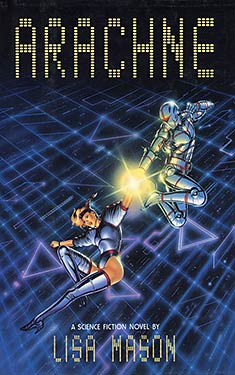Lisa Mason
Completed 5/25/2014, Reviewed 5/25/2014
3 stars
In the future, you can exist and conduct business in virtual
reality. Strapped to a chair and
connected through a port implanted in the neck, you can telelink, and conduct
business in the blink of an eye. Carly
Nolan is a lawyer about to go on her first solo court case in telelink. Seconds before arriving in court to represent
a conglomerate being sued for stealing intellectual property, Carly experiences
a blackout and has a strange vision of spider weaving a web. In the two seconds it takes for the blackout
to clear itself, the judge is furious for the delay, accepts a new court date,
and orders Carly to perimeter probing and recertification.
D. Wolfe, an unscrupulous senior lawyer tries to get Carly
to try an illegal drug called cram which enhances the telelink experience,
believing it will rid her of any bugs in her linking. He also wants to pursue her for a sexual
relationship. The alternative is
perimeter probing, conducted by an AI named Pr. Spinner, who also has ulterior
motives. Pr. Spinner believes the spider
is an archetype, a piece of unprogrammed telelink space that once possessed,
would expand her consciousness beyond the finiteness of her own programming,
but would leave Carly a vegetable, or dead.
Carly is caught between two evils, but must walk through her fear and
anger to stop the blackouts and resume her place as a young aggressive
lawyer.
Coming up with the plot summary of “Arachne”, I had to stop
and reflect on why I didn’t care for the book.
There were a lot of neat concepts.
Telelink is an awesome construct, and it’s easy to see why this book is
hailed as a forerunner of the cyberpunk movement. It’s well-designed and Mason’s prose lends
itself to its wonderful descriptions.
I also really liked Pr. Spinner. With the faceplate of an old woman and her
obsession with obtaining an archetype, the character comes off as a robotic, near-retirement
nurse with an addiction to illegally imported exotic animals. She’s brassy, cruel, but not unfunny.
As Mason began building her universe, I was really
intrigued. Even the physicality of a
post-mega-earthquake San Francisco
is quite remarkable and visionary. But once
all the pieces were in place, that’s where I lost interest. The time between the beginning and the end of
the book just seemed like miscellaneous thrashing. There’s some tension, some interesting and
surprising twists, but it never gelled for me.
Everything between Carly’s three perimeter probes with Spinner felt like
filler. I had a tough time believing the
relationship with Wolfe. It was more
soap than substance.
I give this book three stars. Mason does a much better job with
characterization and relationships in her later book “Summer of Love”. But you can see the potential in her world
building and writing style that came to maturity in her later work.

Thanks! I couldn't help thinking of Phillip K. Dick's UBIK. While in a slightly different context, from an existential standpoint there are similarities. Half-life being analogous to remote-life.
ReplyDeleteThe plot dynamics may have been complicated by a lack of, forgive me, chemistry... Machine consciousness and motivations should be alien to us 'squishy' biological entities. I can sympathize with an author for having trouble with it.
Another earlier work along these lines is COILS by Roger Zelazny and Fred Saberhagen.
Cheers!